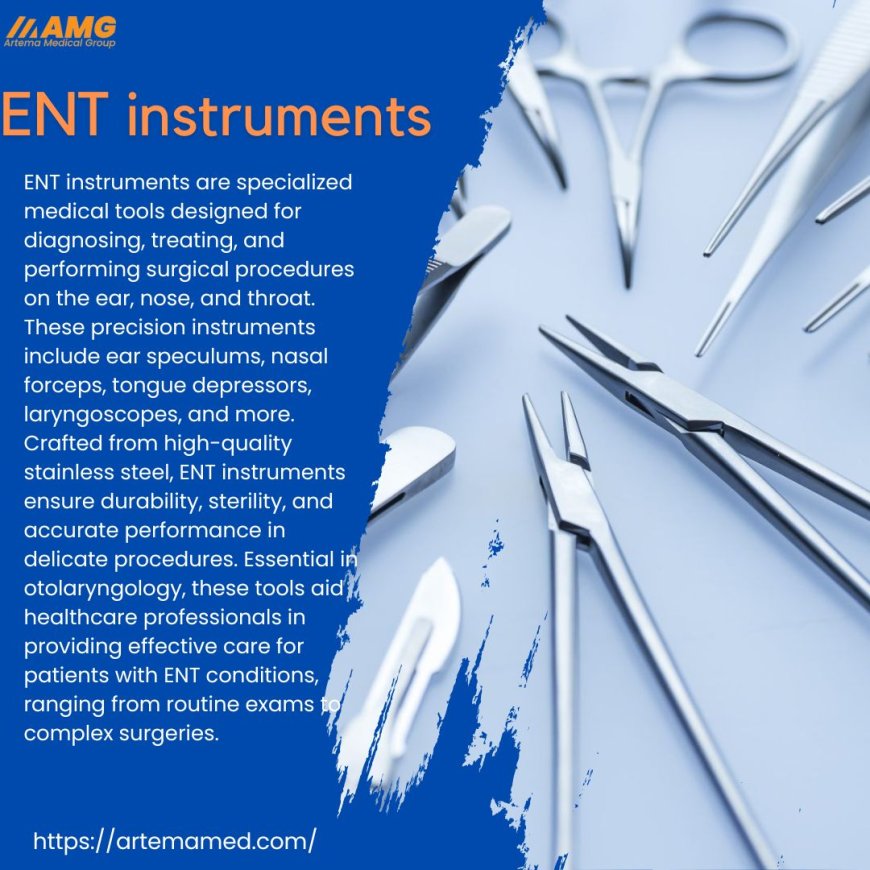Understanding the Working of ENT Instruments in Modern Healthcare
ENT instruments are specialized medical tools designed for diagnosing, treating, and performing surgical procedures on the ear, nose, and throat. These precision instruments include ear speculums, nasal forceps, tongue depressors, laryngoscopes, and more. Crafted from high-quality stainless steel, ENT instruments ensure durability, sterility, and accurate performance in delicate procedures. Essential in otolaryngology, these tools aid healthcare professionals in providing effective care for patients with ENT conditions, ranging from routine exams to complex surgeries.

Understanding the Working of ENT Instruments in Modern Healthcare
ENT instruments, or ear, nose, and throat instruments, are essential tools used in the field of otolaryngology to diagnose, treat, and perform surgical procedures for conditions related to the ear, nose, and throat. These instruments are designed with precision and functionality in mind, enabling healthcare professionals to perform a wide range of diagnostic and surgical tasks. The working mechanisms of ENT surgical instruments are critical in ensuring patient safety and effective treatment. In this article, we will explore how these instruments work and their key roles in medical practice.
1. Diagnostic ENT Instruments
The first step in treating ear, nose, and throat conditions is accurate diagnosis, and this is where ENT instruments play a crucial role. These tools allow physicians to thoroughly examine the patient's anatomy, helping them to identify the underlying issue before deciding on a course of treatment.
-
Otoscope: An otoscope is one of the most commonly used diagnostic tools in ENT. It consists of a magnifying lens and a light source that enables the doctor to look inside the ear canal and observe the eardrum. This instrument works by providing a clear, illuminated view of the ear, making it easier to detect issues such as infections, perforations, or blockages.
-
Nasal Speculum: This instrument helps doctors examine the nasal cavity by gently opening the nostrils. The speculum's adjustable blades allow for a wider view of the nasal passages, making it easier to detect polyps, infections, or deformities that could affect breathing.
-
Laryngoscope: A laryngoscope is used to examine the throat and larynx (voice box). It is equipped with a light and a small mirror or camera that enables the physician to see deep inside the throat. This tool is essential for diagnosing vocal cord disorders, throat cancers, or inflammation.
Working Mechanism: Diagnostic ENT instruments typically work by providing enhanced visualization through magnification and lighting, enabling healthcare professionals to observe internal structures and detect abnormalities with precision.
2. Surgical ENT Instruments
ENT surgical instruments are specifically designed for performing delicate surgeries that involve small and sensitive areas of the ear, nose, and throat. These instruments must offer precise control, sharpness, and reliability to ensure successful outcomes.
-
Tonsil Scissors and Forceps: Used primarily in tonsillectomies, these instruments are designed to cut and remove the tonsils safely. The sharp, curved blades of the scissors make clean cuts around the tonsil tissue, while forceps are used to grip and remove the tissue carefully. The working mechanism involves applying controlled pressure to cut and extract tissue with minimal trauma to surrounding areas.
-
Micro Forceps: Micro forceps are used in ear surgeries, such as tympanoplasty, to manipulate small structures like the eardrum or ossicles (tiny ear bones). These forceps are fine-tipped, allowing surgeons to handle tissues with high precision. Their design enables precise movements, critical in procedures where even the slightest error could damage delicate structures.
-
Endoscopes: Endoscopes are tube-like instruments fitted with a camera and light, used to provide a clear internal view of the nasal passages, sinuses, or throat during surgery. The camera transmits real-time images to a monitor, allowing surgeons to perform minimally invasive procedures without large incisions. This instrument works by threading the tube through natural openings, guiding the camera to the affected area for visual inspection or surgical intervention.
Working Mechanism: ENT surgical instruments work by offering surgeons precise control over delicate tissues, using cutting, grasping, and visualizing mechanisms that ensure accuracy and minimize damage to surrounding tissues.
3. Minimally Invasive ENT Instruments
In modern otolaryngology, there is a growing focus on minimally invasive procedures. ENT instruments are evolving to meet these needs, offering tools that can perform complex surgeries with minimal incisions, reducing patient recovery times and surgical risks.
-
Balloon Sinuplasty Instruments: Balloon sinuplasty is a procedure used to treat chronic sinusitis by expanding blocked sinus passages. The balloon catheter is gently inserted into the sinus opening and inflated to widen the passage, allowing better drainage and reducing pressure. The working principle is simple yet effective: by inflating the balloon, the sinus walls are gently restructured, without the need for cutting or removal of tissue.
-
Microdebriders: These instruments are commonly used for nasal and sinus surgeries. A microdebrider consists of a rotating blade housed inside a hollow tube, which precisely shaves away soft tissues, such as nasal polyps, while suctioning the debris out of the surgical area. This tool is particularly valuable for its dual-function design, which allows simultaneous tissue removal and suction.
Working Mechanism: Minimally invasive ENT instruments use techniques like balloon dilation, tissue shaving, and suction to treat conditions with minimal damage to healthy tissues, making surgeries less traumatic for patients.
4. Visualization Instruments
Accurate visualization is key to any successful diagnosis or surgery, and many ENT instruments are designed to enhance the surgeon's ability to see clearly inside the patient's body.
-
Endoscopic Cameras: Endoscopic cameras provide surgeons with a real-time, magnified view of the areas being treated. These cameras are attached to flexible tubes, which can be inserted into the ear, nose, or throat. The working mechanism involves transmitting high-definition images to a monitor, allowing surgeons to navigate intricate anatomical structures without making large incisions.
-
Microscopes: Surgical microscopes are often used in ear surgeries, such as stapedectomy or cochlear implant placement. These microscopes provide a highly magnified view of the surgical site, allowing surgeons to make precise cuts and sutures. The microscope's working mechanism relies on high-powered lenses that magnify tiny structures, ensuring the accuracy of surgical procedures.
Working Mechanism: Visualization tools in ENT instruments work by enhancing the surgeon’s view of internal structures, allowing for more accurate diagnosis and treatment, especially in minimally invasive and microscopic surgeries.
5. Pediatric ENT Instruments
Children often require specialized ENT instruments that are smaller and designed for their unique anatomical needs. Pediatric ENT instruments are critical for performing safe, effective surgeries on younger patients.
-
Pediatric Otoscopes: These otoscopes are smaller than those used for adults, allowing doctors to examine children's ears more comfortably and accurately. The working mechanism remains the same, but the size and scale are adjusted for pediatric use.
-
Pediatric Adenoidectomy Instruments: These instruments are designed to safely remove adenoids in children suffering from chronic infections or breathing difficulties. The smaller, more delicate design of these instruments ensures that the surgery is less invasive and minimizes post-operative discomfort.
Working Mechanism: Pediatric ENT instruments are scaled-down versions of adult tools, adapted for smaller anatomical structures to ensure safe and effective use on children.
6. Suction and Irrigation Instruments
Suction and irrigation are vital components of many ENT procedures. These instruments help to remove fluids, blood, or debris from the surgical site, keeping it clear and allowing surgeons to work efficiently.
-
Suction Cannulas: Suction cannulas are narrow tubes used to remove fluids from the ear, nose, or throat during surgery. The working mechanism involves a vacuum pump that creates suction, helping to clear the surgical site and maintain visibility.
-
Irrigation Devices: Irrigation devices are used to flush the surgical area with a sterile solution, helping to clean the site and remove debris. The working principle is simple: a controlled stream of fluid is used to wash away blood or other materials, keeping the area sterile and clear for continued surgery.
Working Mechanism: Suction and irrigation instruments work by creating a vacuum or stream of fluid, ensuring that the surgical field remains clean and visible throughout the procedure.
Conclusion
ENT instruments are essential in modern healthcare, enabling otolaryngologists to perform both diagnostic and surgical procedures with precision and confidence. Whether it is a diagnostic otoscope or a highly specialized surgical microdebrider, the working mechanisms of these tools are designed to provide optimal outcomes for patients. Their precision, adaptability, and advanced visualization capabilities make ENT surgical instruments indispensable in treating ear, nose, and throat conditions effectively, improving the overall quality of care in otolaryngology.For more info visit our website Artema med.
What's Your Reaction?
























